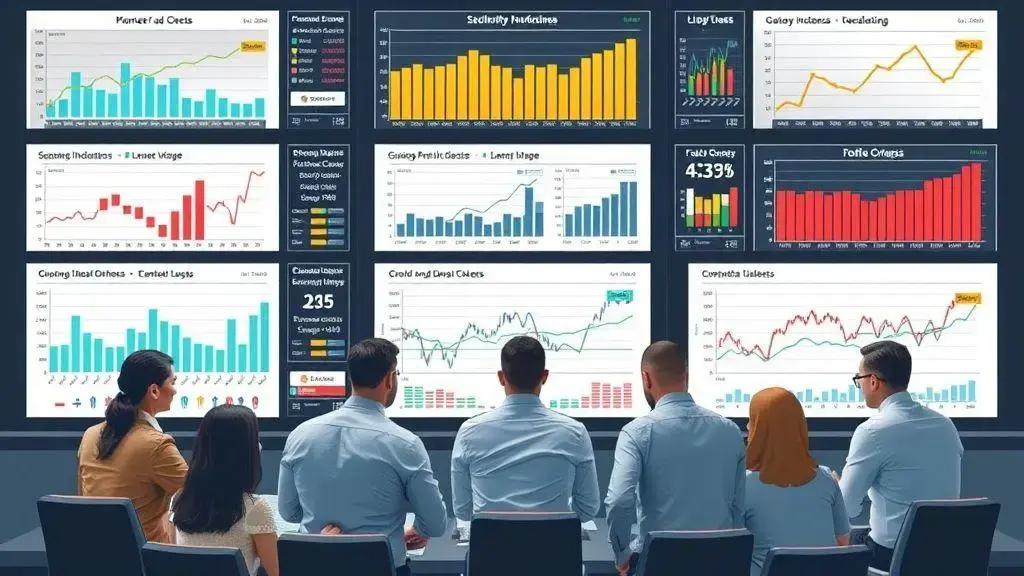Us government economic data: understanding its impact

Us government economic data informs individuals about key economic indicators like inflation and employment rates, enabling smarter personal finance decisions and strategic financial planning.
Us government economic data is more than just numbers; it tells a story about the nation’s financial health. Curious about how it affects you? Let’s dive into the insights it offers.
Understanding the sources of us government economic data
Understanding the sources of us government economic data is essential for grasping how economic decisions are made. These data sources provide valuable insights into the financial health of the nation.
The primary sources of economic data include various government agencies. Each of these organizations collects and analyzes information that plays a critical role in policy-making and economic planning.
The main agencies involved
Several key agencies release economic data that directly impacts the market. Each organization has its focus and specific types of data:
- The Bureau of Economic Analysis (BEA) reports on national income and product accounts.
- The Bureau of Labor Statistics (BLS) provides crucial data on employment and inflation.
- The Federal Reserve gives insights into monetary policy and its effectiveness.
- The Census Bureau collects data on the economy and population demographics.
Through these organizations, the government can better respond to economic conditions. Understanding how each agency contributes allows individuals and businesses to interpret economic data effectively.
Additionally, us government economic data is gathered through various surveys and reports. The consumer price index, for instance, measures changes in the price level of a market basket of consumer goods and services. This helps track inflation and purchasing power.
Watching trends in this data can give insights into future economic conditions. For example, an increase in unemployment rates might signal an upcoming recession, while rising consumer confidence may indicate economic growth.
Moreover, data releases are often accompanied by analysis and commentary from economists and financial experts, making it easier to understand what the numbers mean in a practical context. Being informed about these factors can help guide personal or business financial decisions.
Key metrics to watch in economic reports

When examining us government economic data, it’s essential to know the key metrics to watch. These indicators provide a snapshot of the economic environment and can signal changes in trends.
One critical metric is the Gross Domestic Product (GDP). GDP measures the total value of all goods and services produced over a specific time period. By tracking GDP growth, you can gauge the health of the economy.
Other important economic metrics
Several other key indicators deserve attention:
- Unemployment Rate: This percentage shows the proportion of the workforce that is unemployed but actively seeking employment.
- Consumer Price Index (CPI): CPI tracks the average change in prices paid by consumers for goods and services. It’s crucial for understanding inflation.
- Retail Sales: This figure reflects consumer spending and can indicate economic momentum.
- Housing Starts: The number of new residential construction projects can reveal trends in the housing market.
Tuning into these metrics allows you to interpret market signals better. For instance, if unemployment rates decrease while GDP rises, it suggests a strengthening economy. In contrast, if inflation is high, it may affect purchasing power and consumer behavior.
Moreover, watching these metrics closely can help individuals make informed decisions. For example, understanding retail sales data might guide a business on whether to expand or hold off on new investments based on consumer spending trends.
By synthesizing information from these key indicators, you can form a well-rounded view of the economic landscape. This insight can also benefit strategic planning, whether it’s for personal finances or business operations.
How economic data influences market trends
Economic data plays a significant role in shaping market trends. Understanding how this data influences the economy is essential for making informed decisions, whether you are an investor or a business owner.
At its core, economic data provides insights into consumer behavior, production levels, and overall economic health. This information can sway market sentiment, leading to fluctuations in stock prices and investment strategies.
The connection between data and market reactions
When important reports are released, market participants often react quickly. Some critical data points include:
- Unemployment Rates: A declining unemployment rate typically indicates a healthy economy, prompting investors to be more optimistic.
- Interest Rates: When economic data suggests inflation is rising, central banks may raise interest rates. This may lead to higher borrowing costs, impacting consumer spending and investment.
- Consumer Confidence Index (CCI): When consumers are optimistic about their financial situation, they tend to spend more, affecting overall economic growth.
- Manufacturing Data: Data indicating increased production can suggest higher demand, encouraging investment in stocks related to manufacturing and commodities.
Understanding these data points can provide valuable context for market movements. For instance, if the consumer confidence index shows a dip, it may signal that consumers are hesitant to spend. This could lead to lower retail sales and a potential decline in stock prices for retail companies.
In addition, investors track how economic data aligns with market expectations. For example, if the GDP growth rate comes in above expectations, it may boost stock market performance as investors anticipate stronger corporate profits.
By monitoring economic data, individuals and businesses can better navigate the complexities of the market. You can make more strategic decisions by understanding how various indicators influence market trends and overall economic conditions.
Interpreting government data for personal finance decisions

Interpreting government data is crucial for making informed personal finance decisions. Understanding this data allows individuals to navigate their finances more effectively.
For many, the key to managing personal finances lies in grasping economic indicators. Metrics like the unemployment rate or inflation rate provide insights into economic health and potential changes in financial conditions. For example, if the unemployment rate is low, it may indicate a strong job market, influencing your decision to make larger purchases or investments.
Understanding crucial indicators
There are several critical data points to consider:
- Inflation Rate: This shows how prices for goods and services change. When inflation is high, your purchasing power decreases.
- Gross Domestic Product (GDP): A rising GDP suggests economic growth, which can lead to job stability and income growth.
- Interest Rates: These affect loans and credit. Higher interest rates mean higher costs for borrowing money, which influences big purchases like homes and cars.
- Consumer Confidence: This metric indicates how optimistic consumers feel about the economy. High consumer confidence often leads to increased spending.
By following these metrics, you can anticipate how the economy might affect your financial decisions. For instance, if the Federal Reserve signals an increase in interest rates, you might decide to secure a loan sooner rather than later to avoid higher payments.
When analyzing government data, consider how it impacts your personal financial goals. Say you’re planning to buy a house; keeping an eye on mortgage rates, which often align with federal interest rate trends, can help you choose the right time to buy.
Additionally, understanding these indicators helps you build a sustainable budget. If you know inflation is rising, you might adjust your spending habits to prepare for potential price increases. Overall, staying informed on the data that influences personal finance can empower you to make smarter financial decisions.
FAQ – Frequently Asked Questions about Government Economic Data
What is government economic data?
Government economic data includes statistics that reflect the financial health of a nation, such as GDP, employment rates, and inflation.
How can I use economic data for personal finance?
By understanding economic indicators like inflation and interest rates, you can make more informed decisions about budgeting, saving, and investing.
Why is it important to monitor economic trends?
Monitoring economic trends helps you anticipate changes in the market, allowing you to adapt your financial strategies effectively.
What are some key indicators to watch?
Key indicators include the unemployment rate, consumer confidence index, inflation rate, and retail sales data.





